Michelle Nevius's Blog, page 12
July 14, 2016
Postcard Thursday: The Crystal Palace
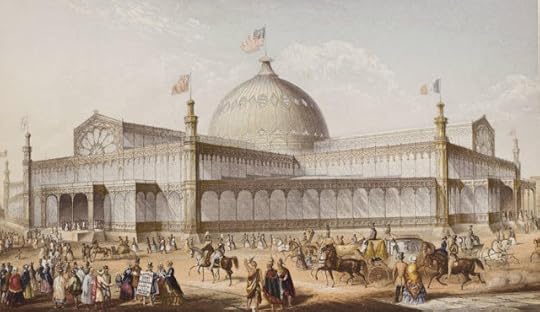
On July 14, 1853, the "Exhibition of the Industry of All Nations" -- better known today as the Crystal Palace Exhibition -- opened in Midtown Manhattan in the small square that would one day become Bryant Park.
Spurred on by London's similar exhibition that showcased the industrial might of the British Empire, the American version of the fair supposedly focused on "all nations" In fact, it was a way for America to show off its growing prominence to the world.
Probably the most famous exhibitor was Elisha Graves Otis, who demonstrated one of the 19th century's most important inventions: the elevator safety brake.
As we write in Inside the Apple :
The idea of the elevator was not new; since antiquity, hoists and pulleys had moved cargo. But ropes frayed and pulleys malfunctioned, which meant that there had never been a viable passenger elevator. Without elevators, commercial buildings were limited to six or seven stories, and rents diminished the farther one had to climb from the street. Otis’s invention was a mechanism to automatically stop an elevator in the event of a fall. And to show the world how much he trusted it, he used himself as the test subject.The story has, over the past 160 years, developed the mystique of legend. In Gotham, Mike Wallace and Edwin Burroughs write that when Otis's platform "reached the highest level, an assistant presented the inventor with a dagger on a velvet cushion" that he used to cut the rope. In the new book Cities are Good For You, Leo Hollis tells a version where Otis is hoisted aloft with "several barrels and heavy boxes, until [he is]... 30 feet above the heads of the throng. After a dramatic pause an assistance cut the hoists with an axe and the crowds gasped as they anticipated seeing the engineer crash to the floor."
One block north of the Crystal Palace grounds stood the Latting Observatory, with a steam-powered elevator which could take visitors up two levels. They would then, however, have to climb stairs to the top of the observatory as no one trusted an elevator to take them higher. For his demonstration Otis got inside the elevator cab, which was suspended from the top of the observatory, and called down to his assistant who—with a dramatic flourish—severed the elevator cable. The cab lurched, dropped an inch, and then shook to a halt, held in place by Otis’ new brake.
Whether it was a dagger or an axe, it was dramatic, and hundreds of people left the observatory that day having witnessed the future. In 1857, Otis installed his patented safety break in the Haughwout china store on Broadway, and it quickly became a tourist attraction. (The store would also become famous in 1861, when Mary Todd Lincoln came to buy a new set of White House china. That's a story we cover in Footprints in New York.)
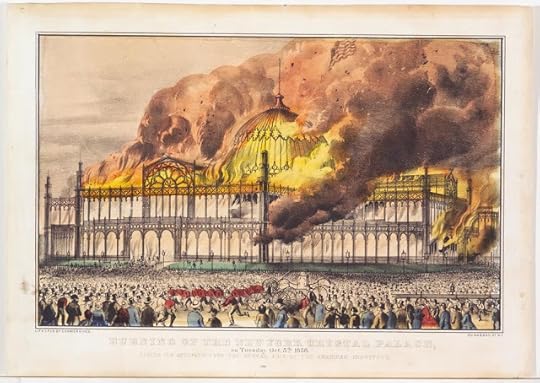
After the exhibition had closed, the Crystal Palace -- built of cast-iron, and thus thought to be fireproof -- dramatically burned to the ground on October 5, 1858.
* * * *
JULY 29 at 6:30PM || ALEXANDER HAMILTON'S NEW YORK
We will be speaking at the New-York Historical Society on Friday, July 29, at 6:30pm. The illustrated talk, which takes you through the New York City Alexander Hamilton would have known, is free with museum admission (which is pay-what-you-wish on Friday nights) but the museum would like you to make a reservation. Click this link for all the details: http://www.nyhistory.org/programs/exploring-hamilton%E2s-new-york
* * * *
Read more about NYC history in
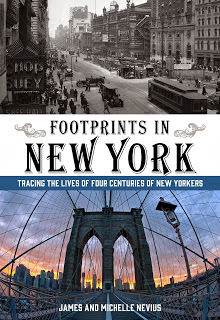
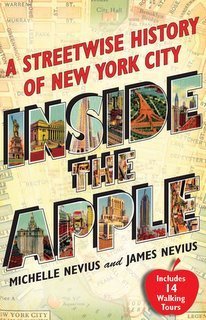
Footprints in New York: Tracing the Lives of Four Centuries of New Yorkers
Inside the Apple: A Streetwise History of New York City
Published on July 14, 2016 08:08
July 7, 2016
Postcard Thursday: The Duel! (And more about Alexander Hamilton)

This Monday, July 11, marks the anniversary of the fateful duel between Alexander Hamilton and Aaron Burr (pictured above) at the so-called "dueling grounds" at Weehawken, New Jersey, in 1804.
As we write in Footprints in New York: Tracing the Lives of Four Centuries of New Yorkers :
According to the Code Duello, gentlemen only needed to meet on the field of honor and delope, or discharge their weapons. They could shoot into the ground and the debt would be satisfied.
Hamilton had resolved before the duel that he would not shoot Burr. In a letter discovered with his will after his death, Hamilton had written: “if our interview is conducted in the usual manner, and it pleases God to give me the opportunity, [I will] reserve and throw away my first fire, and I have thoughts even of reserving my second fire.”
The two men arrived in Weehawken about half an hour apart. Burr and his party, including his second William P. Van Ness, got there first and began clearing the dueling grounds. Hamilton, Nathaniel Pendleton, and David Hosack, a physician, arrived around seven in the morning. By prearrangement, the seconds were to keep their backs turned away from Hamilton and Burr. Since dueling was illegal, this would give them the chance, if questioned, to say they hadn’t seen anything.
Hamilton, as the challenged, had brought the pistols, and he was given the choice of his weapon. Hamilton took his time getting into position. He cleaned his glasses. He repeatedly tested his aim. Was this a show of nerves—or was he trying to provoke Burr? The pistols belonged to Hamilton’s brother-in-law, and he may have had the opportunity to practice with them. Did that give him an unfair advantage? Even if it did, it turned out not to matter.
Hamilton fired first. His bullet flew above Burr’s head, lodging in a cedar tree.
Then Burr fired. His aim was true, and his shot lodged in Hamilton’s spine, having first lacerated his liver. Doctor Hosack, waiting nearby, recalled later: "I found him half sitting on the ground, supported in the arms of Mr. Pendleton. His countenance of death I shall never forget. He had at that instant just strength to say, 'This is a mortal wound, doctor,' when he sunk away, and became to all appearance lifeless…."
Hamilton wasn’t dead—not yet. He was ferried across the river to the home of his friend William Bayard on Jane Street. Bayard was from one of the oldest and richest families in the city—he was the great-great-great nephew of Judith Bayard, wife of Peter Stuyvesant—and owned vast property in what is now Greenwich Village. Hamilton was carried to a second-floor bedroom where Dr. Hosack attended to him. A rider was dispatched to the Grange to fetch Eliza—but only to tell her that Hamilton was suffering from “spasms.” He had hidden the duel from her in advance, but he could hide it no longer.
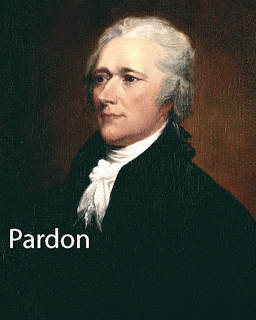
If you want to see the duel reenacted, they will be hosting a program at The New-York Historical Society on Sunday, July 10, at 1pm and 3pm. Details: http://www.nyhistory.org/programs/my-first-friend-my-enemy-hamilton-and-burr-duel-0
...... and last but not least.....
We will be speaking at the New-York Historical Society on Friday, July 29, at 6:30pm. The talk is free with museum admission (which is pay-what-you-wish on Friday nights) but the museum would like you to make a reservation. Click this link for all the details: http://www.nyhistory.org/programs/exploring-hamilton%E2s-new-york
* * * *
Read more about NYC history in


Footprints in New York: Tracing the Lives of Four Centuries of New Yorkers
Inside the Apple: A Streetwise History of New York City
Published on July 07, 2016 12:11
June 30, 2016
Postcard Thursday: Independence Week!
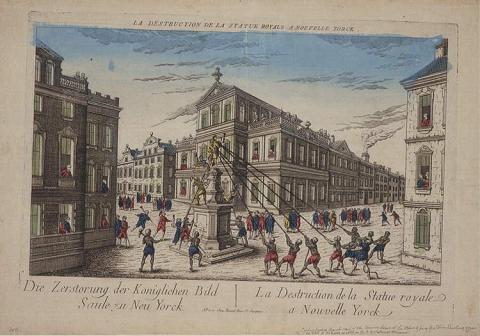 A fanciful version of the felling of King George III's statue in Bowling Green
A fanciful version of the felling of King George III's statue in Bowling GreenAnyone who's ever taken a tour with James knows he's a strong advocate that we shouldn't celebrate just July 4 as Independence Day but the whole week from July 2-9.
Though, we have always celebrated July 4th as the holiday, the actual date of the vote to declare our break from Great Britain was July 2.
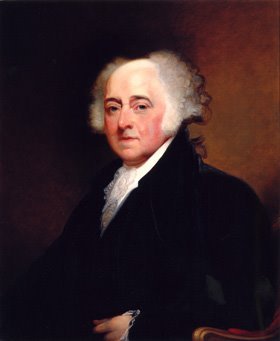 As John Adams wrote in a letter the next day to his wife, Abigail:
As John Adams wrote in a letter the next day to his wife, Abigail:"The second day of July, 1776, will be the most memorable epoch in the history of America. I am apt to believe that it will be celebrated by succeeding generations as the great anniversary festival."Well, he was only off by two days. In fact, only twelve of the thirteen original colonies had voted to declare independence on July 2 -- the delegates from the thirteenth colony, New York (which included such notable citizens as Lewis Morris and Francis Lewis) did not feel they had been invested with such power and retreated from Philadelphia to discuss their options.
Meanwhile, on July 4, the Continental Congress agreed to print the Declaration. Scholars guess that somewhere between 100 and 200 of these Dunlap Broadsides, as they've come to be known, were printed that evening (25 of which exist today), probably under the watchful eye of Thomas Jefferson, the Declaration's lead author. On July 5 and 6, John Hancock had riders dispatch Dunlap Broadsides to colonial cities and on July 9 a copy arrived in New York City, where George Washington's troops were stationed.
That same day, New York agreed to be the thirteenth and final colony to declare independence. (Good thing, since the printed Declaration begins, "The unanimous declaration of the thirteen united states of America.") That night, American troops and the Sons of Liberty tore down the gilded statue of George III in Bowling Green Park, signaling New York's new life as an independent American city.
As we write in Inside the Apple :
The fence that surrounds the Bowling Green today is the original one erected ca. 1771. It is a New York City Landmark and one of the city’s most significant pieces of pre-Revolutionary architecture. If you walk around the outside of the park, you can easily see that the larger fence posts are uneven and that each is rough-hewn in a slightly different way. It is clear that there were once decorative objects at the top of the fence posts, but it remains a mystery what these finials actually looked like, or when they were removed.
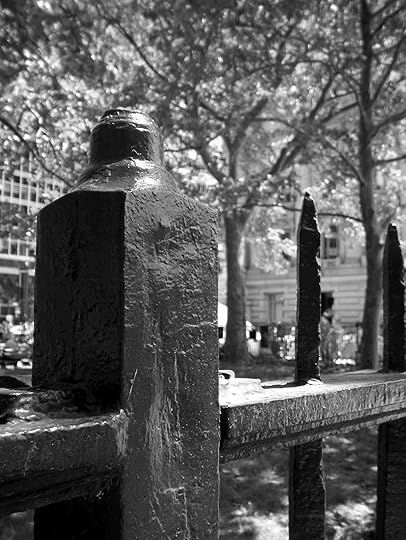
Unlike the king’s statue, the fence is not mentioned in any news reports, diaries or letters of the time. Over the years, it has been posited the finials must have been something round (to be used as cannon balls) or something royal and therefore offensive to Americans. According to the New York Times, during the excavations for the foundations of the elevated railroad in 1878, “one of the round knobs struck from the railing” was unearthed. Later that year it was presented to David van Arsdale, the grandson of a Revolutionary soldier who had a direct role in the end of the war in New York. But that is the only time they are mentioned.Perhaps one will turn up someday and we’ll see exactly what they looked like.
Until then, it’s worth a visit to Bowling Green during this Independence Week to see—and feel—this reminder of the American Revolution. If you're in the neighborhood, signer Francis Lewis is buried at Trinity Church (as is New York's greatest hero of the Revolution, Alexander Hamilton).
..... AND SPEAKING OF ALEXANDER HAMILTON...
Don't miss our illustrated lecture at The New-York Historical Society on Friday, July 29, at 6:30pm.
Read all about it at: http://www.nyhistory.org/programs/exploring-hamilton%E2s-new-york
Please note that the talk is free with museum admission and that museum admission is pay-what-you-wish on Friday nights. The museum would like an RSVP if you are planning to attend, either by calling 212-485-9268, or clicking here .
* * * *
Read more about NYC history in


Footprints in New York: Tracing the Lives of Four Centuries of New Yorkers
Inside the Apple: A Streetwise History of New York City
Published on June 30, 2016 11:55
June 16, 2016
Postcard Thursday: Happy Birthday to the Roller Coaster (Born in Coney Island)

The Cyclone at Coney Island is one of the world's most famous wooden roller coasters, but it was not the first such ride at the amusement parks that lined the boardwalk out there. In fact, the first roller coaster ever built, the Gravity Pleasure Switchback Railway, opened at Coney Island in June 1884. (Sources differ as to whether it opened on June 6 or today, June 16).

Modeled on an earlier coal railroad at Mauch Chunk, Pennsylvania, that had been successfully turned into an entertainment, the switchback was the brainchild of LaMarcus A. Thompson. Visitors would climb to the top of a tower and board a car that then dropped six hundred feet over an undulating track. At the far end the car would be "switched back" to another track and returned to the tower. Thompson envisioned his ride as wholesome family entertainment -- in a period when amusement parks were often seen as dens of sin and iniquity -- and the cars, traveling at an "invigorating" six miles per hour, provided great views of the Coney Island beach and boardwalk.* He charged 5 cents a ride and made back the $1600 he'd invested in the roller coaster in less than three weeks.
It is unclear how long the Switchback Railway lasted at Coney Island (or even precisely where it stood). Despite its early success, Thompson soon faced a host of competitors and his original coaster may only have stood for three years. However, Thompson's career in designing roller coasters was just beginning. Firmly believing that his passengers wanted to see beautiful things as they rode his rides, Thompson went on to create numerous scenic switchback coasters where the cars entered tunnels painted with dioramas of nature scenes. Eventually the painted scenes gave way to dark tunnels, adding to the thrill.
As Thompson built more rides, he improved their technology adding such features as cable pulleys to haul the cars to the top, linked cars to create longer trains, and emergency brakes in case of accident. Though Thompson didn't hold the patent on the original roller coaster,** by the end of his life he had patented more than 30 improvement to the ride and is still known to this day as the "Father of Gravity."
* The ferris wheel -- normally the best place to get a view at an amusement park -- was not invented until the 1893 Chicago World's Fair.
** The patents for the first roller coasters were issued in 1872 and 1878; however neither of the original patentees ever built a working model, making Thompson's ride the first of its kind.
SAVE THE DATEWe'll be talking about "Alexander Hamilton's New York"at the New-York Historical Societyon Friday, July 29, at 6:30pm
Details to follow
* * * *
Read more about NYC history in


Footprints in New York: Tracing the Lives of Four Centuries of New Yorkers
Inside the Apple: A Streetwise History of New York City
Published on June 16, 2016 10:16
June 9, 2016
Postcard Thursday: Fort Hamilton
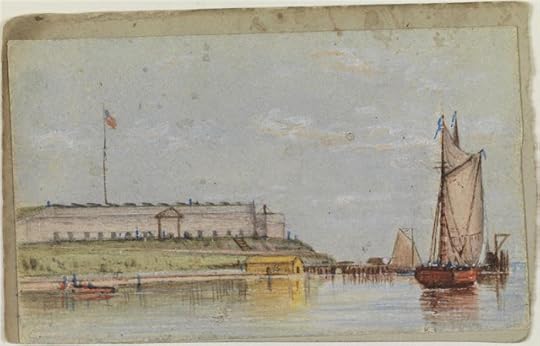 Fort Hamilton, 1875. Courtesy of the Museum of the City of New YorkThis weekend marks the anniversary of the laying of the cornerstone of Fort Hamilton in Brooklyn. On June 11, 1825, construction began on what is now New York's oldest military installation. It is named for General Alexander Hamilton, America's first Treasury Secretary. (This Sunday, the musical based on Hamilton's life is poised to make history by sweeping the Tony Awards.)
Fort Hamilton, 1875. Courtesy of the Museum of the City of New YorkThis weekend marks the anniversary of the laying of the cornerstone of Fort Hamilton in Brooklyn. On June 11, 1825, construction began on what is now New York's oldest military installation. It is named for General Alexander Hamilton, America's first Treasury Secretary. (This Sunday, the musical based on Hamilton's life is poised to make history by sweeping the Tony Awards.)Though the fort's position at the mouth of the Narrows makes it a crucial defensive position, it never saw action; however, artillery mounted near the same spot was used during the American Revolution by patriots to attack incoming British vessels.
The home of Robert E Lee, then a captain and the commander of Fort Hamilton from 1841-1846, is still preserved within the grounds.
***
[image error]
James has a piece in today's Guardian about the debt Hillary Clinton's historic run for the presidency owes to New Yorker Eleanor Roosevelt.
You can read it at: http://www.theguardian.com/commentisfree/2016/jun/09/hillary-clinton-nomination-history-women-rights-advocates
***
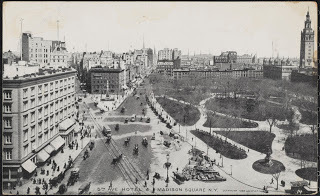 OUR NEXT PUBLIC WALKING TOURis Sunday, June 19, at 1pmof MADISON SQUARE
OUR NEXT PUBLIC WALKING TOURis Sunday, June 19, at 1pmof MADISON SQUARE
Early bird sign ups end on June 14Read all about the tour and sign up by CLICKING HERE
***
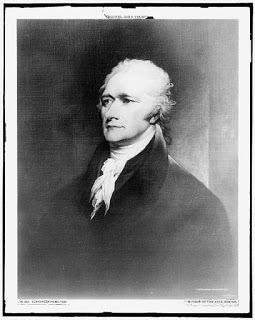
And last but not least
SAVE THE DATEWe'll be talking about "Alexander Hamilton's New York"at the New-York Historical Societyon Friday, July 29, at 6:30pm
Details to follow
* * * *
Read more about NYC history in


Footprints in New York: Tracing the Lives of Four Centuries of New Yorkers
Inside the Apple: A Streetwise History of New York City
Published on June 09, 2016 08:39
June 2, 2016
Postcard Thursday: Madison Square Park Walking Tour on June 19

Thanks to everyone who came out for our Third Annual Alexander Hamilton walk this past weekend. For June, we thought we'd try something a little different and offer a walk that covers a small amount of ground but a wide swath of history:
Everything You Ever Wanted to Know About MADISON SQUARE(but were afraid to ask)
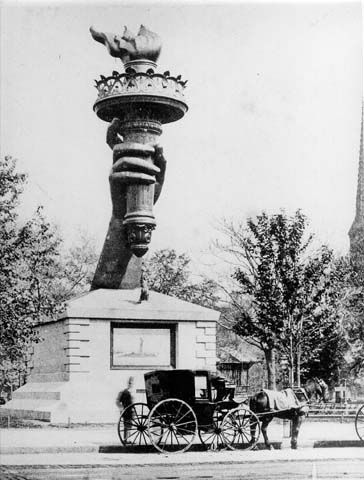
 EVERYTHING YOU EVER WANTED TO KNOW ABOUT MADISON SQUARE(But were afraid to ask)
EVERYTHING YOU EVER WANTED TO KNOW ABOUT MADISON SQUARE(But were afraid to ask)A WALKING TOUR OF MADISON SQUARE with
JAMES NEVIUS
author of
"INSIDE THE APPLE" and "FOOTPRINTS IN NEW YORK"
Sunday, June 19, 2016 at 1:00pm$20 per person -- early bird special (reserve on or before Tuesday, June 14)$25 per person -- for reservations made on or after June 15*** add a copy of FOOTPRINTS IN NEW YORK for just $15 when you reserve online ***
Madison Square is just 6.2 acres, but contains within its boundaries a fascinating cross-section of New York’s history, from the British-colonial era -- when it was a potter’s field -- to its designation as a military drilling ground on the 1811 street plan, to becoming a center of Gilded-Age high society. Who the heck was Roscoe Conkling? Why is Chester Arthur commemorated here? Why is the Flatiron Building so significant in the history of American architecture? All of these questions -- and many more -- will be answered during our perambulation around the park.RESERVE BY CLICKING THE BUTTON (BELOW)
(or email your name, the number in your party, and cell phone contact number to walknyc@gmail.com)
(You should receive a confirmation within 24 hours; if you haven’t received a confirmation in that time frame, please reach out again.)
You may pay by cash or credit card at the start of the tour.Meeting place will be sent via email when you reserve.


 RESERVE NOW | CLICK ME
RESERVE NOW | CLICK ME
 Share
Share
 Tweet
Tweet
 Forward
Forward* * * *
SAVE THE DATE
If you couldn't make the Hamilton walk, take our "virtual tour" of Hamilton's city
on Friday, July 29, at 6:30pm
at the New-York Historical Society
DETAILS TO COME
* * * *
Read more about NYC history in


Footprints in New York: Tracing the Lives of Four Centuries of New Yorkers
Inside the Apple: A Streetwise History of New York City
Published on June 02, 2016 08:23
May 26, 2016
Postcard Thursday: Happy Birthday, Brooklyn Bridge
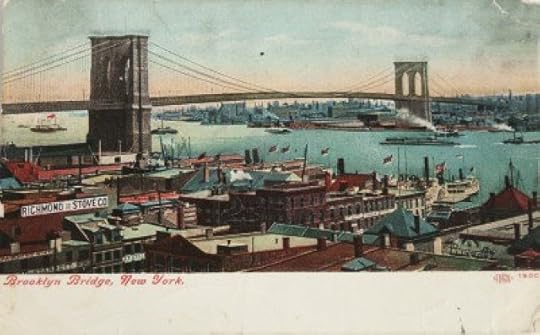
Tuesday passed with very little fanfare, but it was the 133rd birthday of the Brooklyn Bridge, the first of the East River crossings to be built, and the focus of many books, films, and even an Italian gum. (And a full chapter in both Inside the Apple and Footprints in New York.)
May 24 also happens to be the birthday of Queen Victoria, and back in 1883 when the bridge opened, this conjunction of dates proved to be a problem.
Many of the thousands of workers who constructed the bridge between 1869 and 1883 were Irish and they had no great love for the queen. Victoria's ministers were seen as having obstructed aid to the Irish during the great potato famine (which began in 1845) and rumors circulated that the queen had donated only £5 to the Irish -- and on the same day she'd given the same amount to a dog shelter. That wasn't true, but it didn't matter much to New York's large Irish population, who tried to persuade the city to postpone the bridge's opening ceremonies to a different day. The city refused but then began to worry that the bridge workers would cause a disturbance and had to pay for extra police to quell any possible riots.
The grand opening -- an elaborate ceremony that included President Chester A. Arthur, Governor Grover Cleveland, and the mayors of New York and Brooklyn (then still independent cities) -- went smoothly with no violence. Indeed, the biggest problem came a week later when a throng of pedestrians (who had paid a penny each to cross the span) got scared and cried out that the bridge was collapsing, In the ensuing melee, a dozen people were trampled to death.
There's a chapter in Footprints about Seth Low that goes into much greater detail about the bridge's opening day that's worth a look.
LAST CHANCE!RESERVATIONS ARE ALMOST FILLED UPfor our 3rd Annual Alexander Hamilton Memorial Day Weekend Walk
Read all about it and reserve athttp://blog.insidetheapple.net/2016/05/3rd-annual-alexander-hamilton-memorial.html
****
Read more about NYC history in


Footprints in New York: Tracing the Lives of Four Centuries of New Yorkers
Inside the Apple: A Streetwise History of New York City
Published on May 26, 2016 08:56
May 12, 2016
Postcard Thursday: The Woolworth Tower
Today's postcard comes from 1919, just six years after the completion of the Woolworth Building. As the front of this unusual card notes it was "the tallest and most beautiful office building in the world."
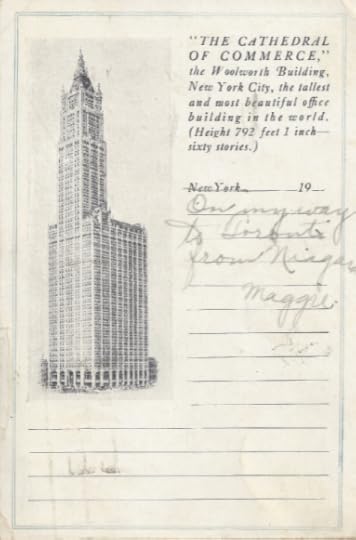
As we write in Inside the Apple :
Today, the tower of the Woolworth Building is in the final stages of being converted into condos; the observation deck is part of the $110-million penthouse, but it's unclear if it will be accessible.
***
REMINDER!RESERVATIONS ARE NOW OPENfor our 3rd Annual Alexander Hamilton Memorial Day Weekend Walk
Read all about it and reserve athttp://blog.insidetheapple.net/2016/05/3rd-annual-alexander-hamilton-memorial.html
****
Read more about NYC history in


Footprints in New York: Tracing the Lives of Four Centuries of New Yorkers
Inside the Apple: A Streetwise History of New York City

As we write in Inside the Apple :
Frank W. Woolworth, the inventor of the dime store in 1878 and the most revolutionary retailer in America since A.T. Stewart, had become rich off a simple notion: low prices and high volume. Not only was everything at Woolworth’s priced at either five or ten cents, all the merchandise was on display. In an era when store clerks normally had to fetch items from the back, the ability to browse store shelves gave buyers greater power over their selections. And, as Woolworth soon realized, it made them purchase more. In 1910, he added the lunch counter to a store in Manhattan—another tool to keep shoppers in the store longer and by 1911, when the Woolworth Corporation was founded, Frank Woolworth was worth millions.
That same year, the company hired Cass Gilbert to build its new corporate headquarters on Broadway. Gilbert, who had just six years earlier finished his Beaux Arts masterpiece, the U.S. Custom House, gracefully transitioned into high-rise construction. He was one of the first New York architects to embrace the idea that tall buildings should actually look tall, and used a variety of techniques to draw the viewer’s eye from the decorated street-level entrances to the soaring tower. The window bays are separated by vertical piers that rise, almost uninterrupted, from the base to the spire. The building is faced in terra cotta that lightens toward the top of the building, emphasizing its height....
Gilbert’s use of neo-Gothic tracery (sometimes referred to as “wedding cake” Gothic) gives the building a medieval feel and, indeed, led Brooklyn minister S. Parkes Cadman to dub it “the Cathedral of Commerce” at its opening gala. Cadman was not only making a commentary on its architectural style but on the fact that in the battle between God and Mammon, Mammon appeared to be winning....
In the end, Woolworth paid about $13.5 million to build the tower out of his own deep pockets.... He was one of the first to realize the sheer publicity value of building a noteworthy skyscraper, from using its image in advertising to having postcards sent around the world showing off his creation. As with all skyscrapers claiming the title of tallest in the world, the Woolworth tower had an observation deck that drew in over a quarter million people a year until it was displaced by the Chrysler Building in 1930....(Immediately after the attack on Pearl Harbor, the government closed the observatory atop the Woolworth Building for fear that the vantage it gave of New York harbor was too strategically important. Later in the war, the copper cladding on the Woolworth’s roof was removed and melted down for the war effort; today, the building is painted green instead.)
Today, the tower of the Woolworth Building is in the final stages of being converted into condos; the observation deck is part of the $110-million penthouse, but it's unclear if it will be accessible.
***
REMINDER!RESERVATIONS ARE NOW OPENfor our 3rd Annual Alexander Hamilton Memorial Day Weekend Walk
Read all about it and reserve athttp://blog.insidetheapple.net/2016/05/3rd-annual-alexander-hamilton-memorial.html
****
Read more about NYC history in


Footprints in New York: Tracing the Lives of Four Centuries of New Yorkers
Inside the Apple: A Streetwise History of New York City
Published on May 12, 2016 09:11
May 5, 2016
Postcard Thursday: Jane Jacobs and Washington Square

Today's postcard is an aerial view of Washington Square and lower Fifth Avenue. The postcard was sent in August 1928, but the image must be from a few years earlier. Notice that No. 1 Fifth Avenue, erected in 1927 (and pictured below), is missing.
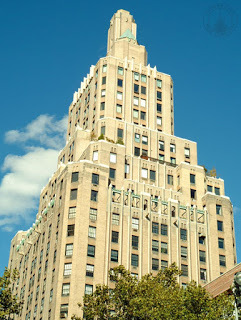 One Fifth AvenueAlso notice that an asphalt road goes through the Washington Arch and continues through to the south side of the square. This was the road the Robert Moses wanted to expand in the 1950s to make the Village more car friendly and to connect uptown traffic to the Lower Manhattan Expressway (LOMEX), which was on the drawing board at the same time.
One Fifth AvenueAlso notice that an asphalt road goes through the Washington Arch and continues through to the south side of the square. This was the road the Robert Moses wanted to expand in the 1950s to make the Village more car friendly and to connect uptown traffic to the Lower Manhattan Expressway (LOMEX), which was on the drawing board at the same time. Robert Moses's plans for a highway through Washington SquareThe road through Washington Square was blocked by Shirley Hayes and Jane Jacobs, whose 100th birthday was yesterday. As part of the birthday celebrations, James wrote a history of the rise and fall of LOMEX for Curbed.com.
Robert Moses's plans for a highway through Washington SquareThe road through Washington Square was blocked by Shirley Hayes and Jane Jacobs, whose 100th birthday was yesterday. As part of the birthday celebrations, James wrote a history of the rise and fall of LOMEX for Curbed.com.You can read the piece at: http://www.curbed.com/2016/5/4/11505214/jane-jacobs-robert-moses-lomex
***RESERVATIONS ARE NOW OPENfor our 3rd Annual Alexander Hamilton Memorial Day Weekend Walk
Read all about it and reserve athttp://blog.insidetheapple.net/2016/05/3rd-annual-alexander-hamilton-memorial.html
****
Read more about NYC history in


Footprints in New York: Tracing the Lives of Four Centuries of New Yorkers
Inside the Apple: A Streetwise History of New York City
Published on May 05, 2016 13:31
May 3, 2016
THIRD ANNUAL ALEXANDER HAMILTON MEMORIAL DAY WEEKEND WALKING TOUR
THIRD ANNUAL ALEXANDER HAMILTON MEMORIAL DAY WEEKEND WALKING TOURwith JAMES NEVIUS author of "Footprints in New York" and "Inside the Apple"
Sunday, May 29, 2016, at 1PM
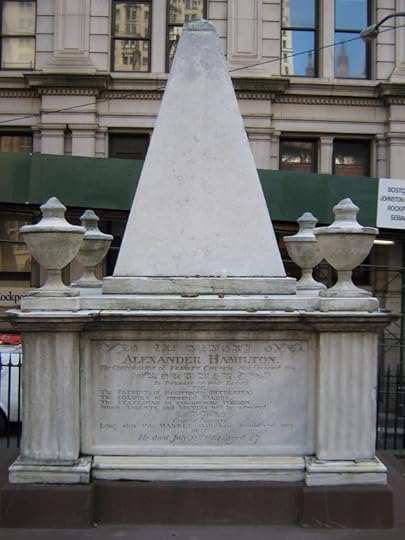
Before HAMILTON was a Broadway sensation (nominated for a record 16 Tony Awards), there was Alexander Hamilton the statesman, Revolutionary War hero, and lousy duellist.
Join author and Hamilton expert James Nevius for a walk back in time as we explore the New York City that Hamilton would have known. We'll look at spots important to his life, to the founding of America, and to his untimely death.
The two-hour walk will take place rain or shine on SUNDAY, MAY 29, at 1PM.
*****
$20 per person (EARLY BIRD SPECIAL) if you sign up on or before Tuesday, May 18.
$25 per person for reservations taken May 19 or later.
Need a copy of "Footprints in New York?" Reserve a signed copy of the book when you register for an additional $15 (the book retails for $20), and we'll bring it to the tour.
****
Payment by cash or credit card at the time of the tour.
Details of where we will meet will be emailed to you when you reserve.
CLICK THE "REGISTER NOW" BUTTON ABOVE TO SAVE YOUR SPOT!
MAY 201629
REGISTER NOW



FOLLOW ON
TWITTER

FOLLOW ON
FACEBOOK

FORWARD TO
A FRIEND
Copyright © 2016 Michelle Nevius Private Walking Tours All rights reserved.
Sunday, May 29, 2016, at 1PM

Before HAMILTON was a Broadway sensation (nominated for a record 16 Tony Awards), there was Alexander Hamilton the statesman, Revolutionary War hero, and lousy duellist.
Join author and Hamilton expert James Nevius for a walk back in time as we explore the New York City that Hamilton would have known. We'll look at spots important to his life, to the founding of America, and to his untimely death.
The two-hour walk will take place rain or shine on SUNDAY, MAY 29, at 1PM.
*****
$20 per person (EARLY BIRD SPECIAL) if you sign up on or before Tuesday, May 18.
$25 per person for reservations taken May 19 or later.
Need a copy of "Footprints in New York?" Reserve a signed copy of the book when you register for an additional $15 (the book retails for $20), and we'll bring it to the tour.
****
Payment by cash or credit card at the time of the tour.
Details of where we will meet will be emailed to you when you reserve.
CLICK THE "REGISTER NOW" BUTTON ABOVE TO SAVE YOUR SPOT!
MAY 201629
REGISTER NOW



FOLLOW ON

FOLLOW ON

FORWARD TO
A FRIEND
Copyright © 2016 Michelle Nevius Private Walking Tours All rights reserved.
Published on May 03, 2016 12:07



